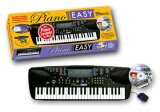The to-do list of the average parent seems endless. My cousin has two daughters, ages 7 and 8. In addition to working outside the home, helping with homework, keeping a clean house and cooking healthy dinners, she is a full-time chauffeur as she shuttles her girls to and from soccer, swimming, karate, singing, Girl Scouts, and more. I can’t even remember all the activities—let alone comprehend how my cousin coordinates the family schedule while maintaining her sanity.
Since the girls are interested in music, I thought Piano Made Easy would be a perfect gift. Mom was relieved since she didn’t have to drive them to (and pay for) yet another lesson to give them the benefits of a basic music education. But it remained to be seen if the Piano Made Easy could compete with DVDs, TV and the Nintendo DS.
Piano Made Easy comes with a 49-key battery operated keyboard, which instantly entranced the girls. The keyboard has 50 voices (including banjo, tuba, church organ, violin, electric guitar and more) for creative play, but the 5 percussion keys (bass drum, snare drum, hit-hat open, high tom-tom, hi-hat close) were the obvious favorite and lent themselves to improvisational composition.
The “Learning” feature helps users learn to play fifty songs, ranging from Twinkle Twinkle Little Star to Pachelbel’s Cannon. In “Learning” mode, the keyboard plays the first note of the song selected and shows the note in the built-in display screen. Once you press the corresponding key on the keyboard, the next note you need to press appears in the display screen. Using this feature, the girls learned to play Twinkle Twinkle Little Star from start to finish.
The Piano Made Easy CD-ROM Game takes children on a musically-guided tour of a virtual zoo with Bill the Zookeeper and his dog Wannabe. In the introduction, Bill explains that although playing the piano looks hard “it is not so hard when you learn piece by piece.” And that seems to be the basic philosophy behind the Piano Made Easy teaching method. There are ten areas in the game (see the map below), and children learn a different concept or note in each beautifully-illustrated area.
Piano Made Easy was designed by music teacher, Mayron Cole. Cole’s belief that counting rhythm is the foundation for music is showcased in the early lessons. An elephant stomps a steady beat for a quarter note, and antelopes teach the eighth note with delicate steps.
By the end of the third lesson, children learn to play eighth, quarter, half, three quarter and whole notes. The lessons are reinforced with clever games and original music. For example, Make A Wish, Starfish! teaches whole notes. Each game can be played slower, faster, or at superstar level, which enables kids to learn at their own pace.
The next six lessons teach kids the names and locations of 7 white keys and 1 black key on the piano. Cole thinks students should learn to play the keyboard by feel without looking at their hands since this is a key skill to have if they want to sight read music in the future. Piano Made Easy doesn’t prohibit looking at your hands, but your attention is naturally drawn to the screen to read the music and follow the beat. There are more than 50 original compositions to play and 10 games which reinforce rhythm and note recognition skills.
Along with the lessons, Piano Made Easy gives kids easy tips to remember the keys. For example, the “D” key is located between the two black keys. “D” is for dog, and the two black keys resemble dog ears.
The last lesson is a concert with all the zoo animals. The girls played the songs over and over until they were able to play them on “SuperStar” mode. They memorized the keys on the piano and were able to keep the beat. And they were clearly having a great time playing.
Piano Made Easy won’t replace piano lessons or teach kids to play Beethoven, Mozart and Rachmaninoff, but it will teach the basic  fundamentals of rhythm and playing the piano in a fun, step-by-step process that makes learning easy.
fundamentals of rhythm and playing the piano in a fun, step-by-step process that makes learning easy.
